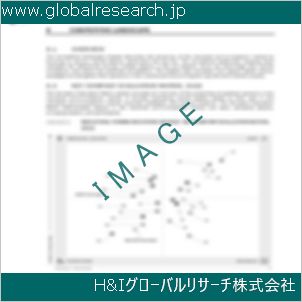Table of Contents
1 Industry Overview of Hydrazine Hydrate
1.1 Definition and Specifications of Hydrazine Hydrate
1.1.1 Definition of Hydrazine Hydrate
1.1.2 Specifications of Hydrazine Hydrate
1.2 Classification of Hydrazine Hydrate
1.3 Applications of Hydrazine Hydrate
1.3.1 Nuclear Application
1.3.2 Non-Nuclear Application
1.4 Industry Chain Structure of Hydrazine Hydrate
1.5 Industry Overview and Major Regions Status of Hydrazine Hydrate
1.5.1 Industry Overview of Hydrazine Hydrate
1.5.2 Global Major Regions Status of Hydrazine Hydrate
1.6 Industry Policy Analysis of Hydrazine Hydrate
1.7 Industry News Analysis of Hydrazine Hydrate
2 Manufacturing Cost Structure Analysis of Hydrazine Hydrate
2.1 Raw Material Suppliers and Price Analysis of Hydrazine Hydrate
2.2 Equipment Suppliers and Price Analysis of Hydrazine Hydrate
2.3 Labor Cost Analysis of Hydrazine Hydrate
2.4 Other Costs Analysis of Hydrazine Hydrate
2.5 Manufacturing Cost Structure Analysis of Hydrazine Hydrate
2.6 Manufacturing Process Analysis of Hydrazine Hydrate
3 Technical Data and Manufacturing Plants Analysis of Hydrazine Hydrate
3.1 Capacity and Commercial Production Date of Global Hydrazine Hydrate Major Manufacturers in 2023
3.2 Manufacturing Plants Distribution of Global Hydrazine Hydrate Major Manufacturers in 2023
3.3 R&D Status and Technology Source of Global Hydrazine Hydrate Major Manufacturers in 2023
3.4 Raw Materials Sources Analysis of Global Hydrazine Hydrate Major Manufacturers in 2023
4 Capacity, Production and Revenue Analysis of Hydrazine Hydrate by Regions, Types and Manufacturers
4.1 Global Capacity, Production and Revenue of Hydrazine Hydrate by Regions 2019-2024
4.2 Global and Major Regions Capacity, Production, Revenue and Growth Rate of Hydrazine Hydrate 2019-2024
4.3 Global Capacity, Production and Revenue of Hydrazine Hydrate by Types 2019-2024
4.4 Global Capacity, Production and Revenue of Hydrazine Hydrate by Manufacturers 2019-2024
5 Price, Cost, Gross and Gross Margin Analysis of Hydrazine Hydrate by Regions, Types and Manufacturers
5.1 Price, Cost, Gross and Gross Margin Analysis of Hydrazine Hydrate by Regions 2019-2024
5.2 Price, Cost, Gross and Gross Margin Analysis of Hydrazine Hydrate by Types 2019-2024
5.3 Price, Cost, Gross and Gross Margin Analysis of Hydrazine Hydrate by Manufacturers 2019-2024
6 Consumption Volume, Consumption Value and Sale Price Analysis of Hydrazine Hydrate by Regions, Types and Applications
6.1 Global Consumption Volume and Consumption Value of Hydrazine Hydrate by Regions 2019-2024
6.2 Global and Major Regions Consumption Volume, Consumption Value and Growth Rate of Hydrazine Hydrate 2019-2024
6.3 Global Consumption Volume and Consumption Value of Hydrazine Hydrate by Types 2019-2024
6.4 Global Consumption Volume and Consumption Value of Hydrazine Hydrate by Applications 2019-2024
6.5 Sale Price of Hydrazine Hydrate by Regions 2019-2024
6.6 Sale Price of Hydrazine Hydrate by Types 2019-2024
6.7 Sale Price of Hydrazine Hydrate by Applications 2019-2024
6.8 Market Share Analysis of Hydrazine Hydrate by Different Sale Price Levels
7 Supply, Import, Export and Consumption Analysis of Hydrazine Hydrate
7.1 Supply, Consumption and Gap of Hydrazine Hydrate 2019-2024
7.2 Global Capacity, Production, Price, Cost, Revenue, Supply, Import, Export and Consumption of Hydrazine Hydrate 2019-2024
7.3 USA Capacity, Production, Price, Cost, Revenue, Supply, Import, Export and Consumption of Hydrazine Hydrate 2019-2024
7.4 EU Capacity, Production, Price, Cost, Revenue, Supply, Import, Export and Consumption of Hydrazine Hydrate 2019-2024
7.5 China Capacity, Production, Price, Cost, Revenue, Supply, Import, Export and Consumption of Hydrazine Hydrate 2019-2024
7.6 Japan Capacity, Production, Price, Cost, Revenue, Supply, Import, Export and Consumption of Hydrazine Hydrate 2019-2024
8 Major Manufacturers Analysis of Hydrazine Hydrate
8.1 Manufacturer One
8.1.1 Company Profile
8.1.2 Product Picture and Specifications
8.1.2.1 Type I
8.1.2.2 Type II
8.1.2.3 Type III
8.1.3 Capacity, Production, Price, Cost, Gross and Revenue
8.1.4 Contact Information
8.2 Manufacturer Two
8.2.1 Company Profile
8.2.2 Product Picture and Specifications
8.2.2.1 Type I
8.2.2.2 Type II
8.2.2.3 Type III
8.2.3 Capacity, Production, Price, Cost, Gross and Revenue
8.2.4 Contact Information
8.3 Manufacturer Three
8.3.1 Company Profile
8.3.2 Product Picture and Specifications
8.3.2.1 Type I
8.3.2.2 Type II
8.3.2.3 Type III
8.3.3 Capacity, Production, Price, Cost, Gross and Revenue
8.3.4 Contact Information
8.4 Manufacturer Four
8.4.1 Company Profile
8.4.2 Product Picture and Specifications
8.4.2.1 Type I
8.4.2.2 Type II
8.4.2.3 Type III
8.4.3 Capacity, Production, Price, Cost, Gross and Revenue
8.4.4 Contact Information
8.5 Manufacturer Five
8.5.1 Company Profile
8.5.2 Product Picture and Specifications
8.5.2.1 Type I
8.5.2.2 Type II
8.5.2.3 Type III
8.5.3 Capacity, Production, Price, Cost, Gross and Revenue
8.5.4 Contact Information
…
9 Marketing Trader or Distributor Analysis of Hydrazine Hydrate
9.1 Marketing Channels Status of Hydrazine Hydrate
9.2 Traders or Distributors with Contact Information of Hydrazine Hydrate by Regions
9.3 Ex-work Price, Channel Price and End Buyer Price Analysis of Hydrazine Hydrate
9.4 Regional Import, Export and Trade Analysis of Hydrazine Hydrate
10 Industry Chain Analysis of Hydrazine Hydrate
10.1 Upstream Major Raw Materials Suppliers Analysis of Hydrazine Hydrate
10.1.1 Major Raw Materials Suppliers with Contact Information Analysis of Hydrazine Hydrate
10.1.2 Major Raw Materials Suppliers with Supply Volume Analysis of Hydrazine Hydrate by Regions
10.2 Upstream Major Equipment Suppliers Analysis of Hydrazine Hydrate
10.2.1 Major Equipment Suppliers with Contact Information Analysis of Hydrazine Hydrate
10.2.2 Major Equipment Suppliers with Product Pictures Analysis of Hydrazine Hydrate by Regions
10.3 Downstream Major Consumers Analysis of Hydrazine Hydrate
10.3.1 Major Consumers with Contact Information Analysis of Hydrazine Hydrate
10.3.2 Major Consumers with Consumption Volume Analysis of Hydrazine Hydrate by Regions
10.4 Supply Chain Relationship Analysis of Hydrazine Hydrate
11 Development Trend of Analysis of Hydrazine Hydrate
11.1 Capacity, Production and Revenue Forecast of Hydrazine Hydrate by Regions and Types
11.1.1 Global Capacity, Production and Revenue of Hydrazine Hydrate by Regions 2024-2029
11.1.2 Global and Major Regions Capacity, Production, Revenue and Growth Rate of Hydrazine Hydrate 2024-2029
11.1.3 Global Capacity, Production and Revenue of Hydrazine Hydrate by Types 2024-2029
11.2 Consumption Volume and Consumption Value Forecast of Hydrazine Hydrate by Regions, Types and Applications
11.2.1 Global Consumption Volume and Consumption Value of Hydrazine Hydrate by Regions 2024-2029
11.2.2 Global and Major Regions Consumption Volume, Consumption Value and Growth Rate of Hydrazine Hydrate 2024-2029
11.2.3 Global Consumption Volume and Consumption Value of Hydrazine Hydrate by Types 2024-2029
11.2.4 Global Consumption Volume and Consumption Value of Hydrazine Hydrate by Applications 2024-2029
11.3 Supply, Import, Export and Consumption Forecast of Hydrazine Hydrate
11.3.1 Supply, Consumption and Gap of Hydrazine Hydrate 2024-2029
11.3.2 Global Capacity, Production, Price, Cost, Revenue, Supply, Import, Export and Consumption of Hydrazine Hydrate 2024-2029
11.3.3 USA Capacity, Production, Price, Cost, Revenue, Supply, Import, Export and Consumption of Hydrazine Hydrate 2024-2029
11.3.4 EU Capacity, Production, Price, Cost, Revenue, Supply, Import, Export and Consumption of Hydrazine Hydrate 2024-2029
11.3.5 China Capacity, Production, Price, Cost, Revenue, Supply, Import, Export and Consumption of Hydrazine Hydrate 2024-2029
11.3.6 Japan Capacity, Production, Price, Cost, Revenue, Supply, Import, Export and Consumption of Hydrazine Hydrate 2024-2029
12 New Project Investment Feasibility Analysis of Hydrazine Hydrate
12.1 New Project SWOT Analysis of Hydrazine Hydrate
12.2 New Project Investment Feasibility Analysis of Hydrazine Hydrate
13 Conclusion of the Global Hydrazine Hydrate (CAS 7803-57-8) Industry 2024 Market Research Report
| ※参考情報 ヒドラジン水和物は、化学式N2H4・H2Oで表される化合物で、ヒドラジンに水分子が結合した形で存在します。CAS番号は7803-57-8です。ヒドラジン自体は無色の、臭いがあるかすかな液体で、高い反応性を持ち、さまざまな化学反応に利用されていますが、ヒドラジン水和物はそれに水が加わることで、より安定した形態を提供します。 ヒドラジン水和物の最大の特徴は、その非常に反応性の高い性質です。特に、酸化剤や還元剤としての能力が強く、多くの有機合成や無機化学において重要な役割を果たします。また、熱や圧力に対して敏感であり、特定の条件下では急激に分解することもあるため、取り扱いには注意が必要です。水和物という形態をとることで、ヒドラジンの揮発性を低減し、より安全に取り扱うことが可能になります。 ヒドラジン水和物にはいくつかの種類があり、一般的には1.0水和物や1.5水和物など、異なる水の結合量に応じて分類されます。これらの形態は、水分子の割合が異なるため、物理的・化学的性質にも違いが出てきます。各種類は、必要とされる特性に応じて使い分けられます。 用途としては、ヒドラジン水和物は多岐にわたります。化学合成においては、ヒドラジンはアミンの合成や、さらには医薬品の中間体としても利用されます。特に、抗癌剤や抗生物質の製造に必要な化合物を合成する際には、重要な役割を果たします。また、農薬や殺虫剤の合成にも使用されることがあります。このように、ヒドラジン水和物は化学工業において不可欠な材料といえるでしょう。 また、ヒドラジン水和物は推進剤としても利用されています。ロケットや航空機のエンジンにおいて、燃料として用いられることがあり、高効率の燃焼が可能です。この用途は、ヒドラジンの高いエネルギー密度に依存しており、特に宇宙開発においてはその重要性が高まっています。推進剤として使用される場合、ヒドラジンは酸化剤と混合され、反応によって生成されるガスが推進力を生み出します。 さらに、ヒドラジン水和物は、各種の化学プロセスにおいて還元剤としても使用されます。特定の金属イオンを還元することで、金属ナノ粒子の合成や、さまざまな有機化合物の還元反応を促進することが可能です。このため、化学分析や材料開発においても重要な役割を担っています。 関連技術としては、ヒドラジン水和物を使用した新しい合成方法やプロセスが開発され続けています。特に、環境に対する配慮から、省エネルギーで効率的な方法の開発が急がれています。また、ヒドラジンを利用した新しい触媒の開発も進んでおり、反応性や選択性の向上が期待されています。 取り扱いに関しては、ヒドラジン水和物は非常に毒性が高いため、適切な安全対策が必要です。OSHA(米国労働安全衛生局)やEPA(米国環境保護庁)などにより、取り扱い基準が設けられています。保護具の着用や、通風が良い場所での作業が推奨されるほか、適切な廃棄処理が必要です。万が一、皮膚や目に触れた場合はすぐに流水で洗い流し、必要に応じて医師の診断を受けることが重要です。 総じて、ヒドラジン水和物は、その特異な性質により、さまざまな化学および工業プロセスで活用されており、未来の技術発展にも寄与する可能性を秘めた化合物です。スピーディーな反応性、強力な還元力、さらには推進剤としての応用など、多くの分野での利用が期待されていますが、その取り扱いや管理には細心の注意が必要です。科学者や技術者は、これらの特性を活かしつつ、安全かつ効果的にヒドラジン水和物を用いる方法を模索し続けています。急速に進化する化学技術の中で、今後も重要な役割を果たしていくことでしょう。 |
❖ 免責事項 ❖
http://www.globalresearch.jp/disclaimer












